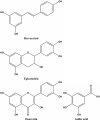The biological responses to resveratrol and other polyphenols from alcoholic beverages
- PMID: 19519720
- PMCID: PMC2782726
- DOI: 10.1111/j.1530-0277.2009.00989.x
The biological responses to resveratrol and other polyphenols from alcoholic beverages
Abstract
Although excessive consumption of ethanol in alcoholic beverages causes multi-organ damage, moderate consumption, particularly of red wine, is protective against all-cause mortality. These protective effects could be due to one or many components of the complex mixture of bioactive compounds present in red wine including flavonols, monomeric and polymeric flavan-3-ols, highly colored anthocyanins as well as phenolic acids and the stilbene polyphenol, resveratrol. The therapeutic potential of resveratrol, firstly in cancer chemoprevention and then later for cardioprotection, has stimulated many studies on the possible mechanisms of action. Further indications for resveratrol have been developed, including the prevention of age-related disorders such as neurodegenerative diseases, inflammation, diabetes, and cardiovascular disease. These improvements are remarkably similar yet there is an important dichotomy: low doses improve cell survival as in cardio- and neuro-protection yet high doses increase cell death as in cancer treatment. Fewer studies have examined the responses to other components of red wine, but the results have, in general, been similar to resveratrol. If the nonalcoholic constitutents of red wine are to become therapeutic agents, their ability to get to the sites of action needs to be understood. This mini-review summarizes recent studies on the possible mechanisms of action, potential therapeutic uses, and bioavailability of the nonalcoholic constituents of alcoholic beverages, in particular resveratrol and other polyphenols.
Figures


References
-
- Aggarwal BB, Bhardwaj A, Aggarwal RS, Seeram NP, Shishodia S, Takada Y. Role of resveratrol in prevention and therapy of cancer: preclinical and clinical studies. Anticancer Res. 2004;24:2783–2840. - PubMed
-
- Alarcón de la Lastra CA, Villegas I. Resveratrol as an antioxidant and prooxidant agent: mechanisms and clinical implications. □Biochem Soc Trans. 2007;35:1156–60. - PubMed
-
- Alcendor RR, Gao S, Zhai P, Zablocki D, Holle E, Yu X, Tian B, Wagner T, Vatner SF, Sadoshima J. Sirt1 regulates aging and resistance to oxidative stress in the heart. Circ Res. 2007;100:1512–1521. - PubMed
-
- Ates O, Cayli S, Altinoz E, Gurses I, Yucel N, Sener M, Kocak A, Yologlu S. Neuroprotection by resveratrol against traumatic brain injury in rats. Mol Cell Biochem. 2007;294:137–144. - PubMed
Publication types
MeSH terms
Substances
Grants and funding
LinkOut - more resources
Full Text Sources
Medical

